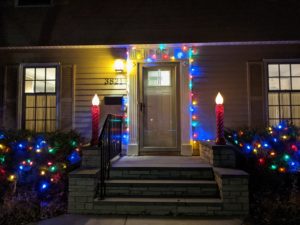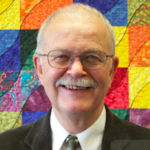
At our house the first official act of Christmas preparation is finding the strings of outdoor Christmas lights from last year and saying a silent prayer that they’ll light again this year. They didn’t, so we had to pop for new ones this year. As you can see from the picture, we also have two large, vintage Christmas candles that we put out on either side of the front door. These once belonged to my wife Susan’s grandparents, and putting them out is a way to remember and honor them.
Like our lights, the bulbs in these candles had also burned out. We thought about just putting the candles out and not replacing the bulbs, but our next door neighbors called us on it, so now, again as you see from the picture, the candles are shining bright.
As someone who lives with major depression, I have learned that it’s important not to let any opportunity to celebrate go by. So every time we come home after dark, and here in Minnesota it’s dark by 4:30 pm this time of year, we celebrate that our lights are up, that they are lit, and that our neighbors are happy for another year.
In Minnesota Christmas lights are a way of keeping long winter nights from weighing too heavily, reminding us that before too long the days will start getting longer again. As we celebrate, the promise of our Christmas lights becomes part of the promises we hear in church, the light shining in the darkness that the darkness cannot overcome, the light of the Advent candles that mark our journey towards Christmas.
Last Sunday in church we lit the first of these candles, the one that signifies hope. As Christians, we come to Advent with hope that the love of God made flesh, the birth of Jesus, will yet again bring light into our troubled world. Deep in the second year of a pandemic, locked in a struggle for racial justice, indeed for justice on many fronts, we need hope to sustain us. So again this year we light the candle of hope and turn our eyes again to what happened at Bethlehem long ago.
People living with mental illness also need hope. It’s both a sustaining hope and a daily hope, a reason to get out of bed and face another day. It’s a tough, realistic hope: honest about how bad things can be and also honest that they can be better. It’s largely sustained by other people, people who help, people who care, people who by the example of their own recovery support the hope of others struggling to believe that their recovery is possible. I don’t believe that you can give this hope to yourself. I do believe that you can catch it from other people.
In this way, the hope for recovery is not that different from the hope we feel in church. It doesn’t come to us in isolation but in company, from other people who share their hope with us when ours has run dry. I’m blessed to be part of a church community, First UCC in Northfield, Minnesota, that nourishes my hope. I’m blessed to be part of a mental health community, Vail Place Uptown, a clubhouse for people living with mental illness in south Minneapolis, that does the same. They couldn’t be more different; they couldn’t be more alike.
I think about these things as I look at our Christmas lights. The new lights we bought are really bright, maybe we overdid it. But I think about somebody coming down our street some night, maybe they’ve had a bad day, maybe for a little while our lights will take their mind off what’s been bothering them. Thinking this way makes me happy that we put up really bright lights this year. And we’ll keep them up until well past Christmas, only take our lights down when the days are getting longer and hope for spring returns. They’re new, and they’ll get us through the winter.

Bob Griggs
Ordained in 1973, Bob Griggs has served UCC churches in Massachusetts, New Hampshire, and Minnesota. He is an Advisory Council member at Vail Place, a club house for people living with mental illness. He is also the author of A Pelican of the Wilderness: Depression, Psalms, Ministry, and Movies and Recovering from Depression: Forty-Nine Helps.